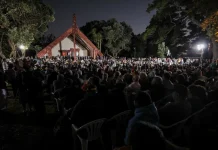Review by Carolyn Skelton. See also, Part Two: “Roots” (2016): persistence of power… and the enduring spirit of resistance Roots (2016, TV series) is disturbing but also compelling: a story of horrific brutality endured, and of the resistant warrior spirit, struggling for freedom. It tells of how the past impacts on present and future generations. It shows the best and worst of humanity, and points to the way both continue today. (Episodes 3 and 4 available on demand on TVNZ website for another week.) Alex Haley’s fictionalisation of his search for his African (become African-American) ancestry was first written as a novel (Roots: The making of an American family, 1976 ). It begins with the story of the enslavement of Kunte Kinte, taken from his Gambian home town of Juffure. The family saga was made into an acclaimed 1977 TV series (See PBS on “Miniseries: Roots Special” 2013) The accuracy of Haley’s family history is disputed, but the story and context seems pretty true to the social history of slavery and the continuing struggles of African Americans. Compared with the 1977 TV series, the 2016 version has been updated to include more accurate historical information. The new version characterises Juffure as “a busy commercial trade post” rather than a rural backwater. In 2016 Kunta Kinte is portrayed as a warrior, compared with the more childlike version of 1977. (Caitlin Gallagher on the differences) The 2016 TV series re-make begins with the story of Kunta Kinte (Malachi Kirby), born in Juffre and trafficked as a teenager to Virginia in the 1770s. The story begins in some of the earliest phases of globalisation that accompanied the shift from feudalism, through mercantile trading, to industrial capitalism. (See also Wikipedia on the 2016 version and imdb) The rise of the use of African slaves in the southern states of the US followed from use of Irish, Scottish, English and German people as well as Africans as indentured servants in early 17th century colonial America. In the 17th century there was a gradual shift from indentured servitude to the use of Africans as chattel slaves, whereby humans are owned as property and have no personal freedom or rights. (History of Slavery in America, Berkley University) The series shows the lives and struggles of Kinte and his descendants across several decades, until the end of the US Civil War and the abolition of slavery in the 1860s. The politics of naming, the importance of family, and of teaching each generation their family lineage, are recurring themes throughout the generations. So to is the recurring treachery, bigotry, misogynistic rape, inhumanity and brutality endured. It starkly portrays the exploitation and abuse carried out by the slave masters in order to acquire and maintain their wealth, status and power over others. And it shows the ways in which each new generation follows Kinte’s example with brave bids for freedom as well as resistance to enslavement in small and large ways: there are moments of success, but their oppression continues, and sometimes changes with other social and economic changes. (See the History website and the Civil War Trust website) The 2016 series adds the story of Kinte and his contemporaries participation in the American War of Independence in 1782, and his grandson Chicken George (Regé Jean-Page) in the US Civil War (1861-65). Both re-tellings show how the slaves were viciously betrayed by the armies they pledged to support in return for promises of freedom. The black men were cynically used as inadequately armed canon fodder. The family bonds, love, solidarity, support, and the selfless sacrifice to protect others among the community of slaves makes their lives durable. For the viewer this is both distressing and uplifting. Kinte and his descendants endeavour to make the best of the circumstances that enslave them. The first aim is to survive. Individuals make choices about when to fight, and when to be prepared to die to protect others. Those that colonise others as a means to maintain their power and status, do so in part by denying the impact of the legacies of the past on present and future lives. The aim of the slave managers is to make the slaves forget their past lives and heritage, by giving them a slave name, and constructing false, and demeaning traditions for them to follow. Kunte Kinte’s supreme act of resistance is to continue to say his name, “I am Kunte Kinte”, as the slave master viciously whips the skin off his back. Eventually, near death, Kinte chooses to live, and says his slave name, “Toby.” But, as The Fiddler (Forest Whitaker) tells him, Kinte will keep his true name, and the spirit it signifies, inside hm. It is necessary to know your name and lineage to know who you are (and what you can be). In part II I will say more about Roots (2016) and the impact of past oppressions on present and future lives. Nina Simone wrote and sang a powerful song, describing four women, whose lives have been constructed out of the legacy of slavery. Each woman is characterized by a slave naming, first as a lament, then, for the fourth woman, her name is sung with anger and bitter irony. https://youtu.be/4grGAYx9koA]]>
Thursday 8th of February 2024 06:53:29 PM
© Copyright 2023 EveningReport.nz and Multimedia Investments Ltd. All rights reserved.









